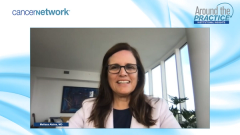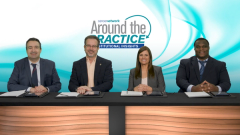
Patient Profile 1: Transplant-Eligible Newly Diagnosed Multiple Myeloma
Centering focus on a patient scenario of transplant-eligible newly diagnosed multiple myeloma, panelists consider the role of induction therapy and transplant in this setting.
Episodes in this series

Transcript:
Melissa Alsina, MD: These are great discussions. I think we have a case, a presentation, that will help us put what we have discussed in a more practical context. Ken, do you want to discuss or present our first case?
Ken Shain, MD, PhD: Our first case is a 64-year-old male, who presents with bilateral rib cage pain back in 2020. Further studies demonstrate a SPEP [serum protein electrophoresis], identified as a 4.5-gram IgA [immunoglobulin A] kappa M-spike [monoclonal spike]. His total protein was elevated as well, and artifactual light chains were also elevated with 850 milligrams of kappa. We don’t have the ratio here, but elevated I’m sure. We do know his creatinine was OK; his calcium was elevated as well, 11.3, [common in] somebody with active disease. A bit anemic at 10.5. Again, white cells were OK, plus normal beta 2 is 5.5. So ISS [International Staging System] 3 is that albumin was 3.1. So that’s our patient. We do some more imaging to see what’s going on with his bones. CT imaging demonstrates diffuse lytic bone disease, with a pathological fracture at the right 7th rib. And then we got a whole body PET [positron emission tomography]-CT, which is appropriate today, looking at the entire body, and again confirm the widespread lytic lesions, including the lumbar and thoracic spine as well as the rib cage. How are we going to treat this gentleman, panelists? Dr Blue, based on the discussion we just had?
Brandon Blue, MD: One of the big questions I would want to ask is, what happens in the patient’s bone marrow? Do we see any high-risk cytogenetics, or can you give me any context there?
Ken Shain, MD, PhD: The bone marrow biopsy was done. Just last night I got the email, essentially, there were about 44% plasma cells, the capillary chain was restricted, and there was a translocation t (4;14) and amlodipine 21.
Brandon Blue, MD: I think the reason why that’s important is because while I think about the induction regimen, with this patient, I would probably lean toward the 4 drugs because in this case this patient is probably very symptomatic due to those widespread lytic lesions. You want to make sure that you have rapid disease control. And not only that, you want to make sure that this patient is considered a potential candidate for a stem cell transplant. However, after transplant, we have some options. And we can say, well, we see that these patients, the natural biology of their disease may be one, that traditional lenalidomide [Revlimid] maintenance may not suffice or provide the type of progression-free survival that you would have hoped. So you have options to do what they consider doublet maintenance by adding on an extra likely proteasome inhibitor to the lenalidomide. For this patient upfront, I would say I want to get the disease under control, to go from symptomatic to asymptomatic, which may even include some radiation therapy, and would for sure, try to make sure that this patient gets a longer progression-free survival by considering them for autologous stem cell transplant.
Ken Shain, MD, PhD: Dr Baz, any additional comments or concerns?
Rachid Baz, MD: I think what we don’t know is the patient’s past medical history, whether the patient has neuropathy, cardiovascular disease, a 64-year-old patient may have diabetes also. These are all possibilities that may change my recommendations a little bit, but I generally agree with the 4-drug induction regimen. I would probably try to hold off radiation unless we have the record compression or there was something that really compelled me to do it. With our regimens that have very high response rates, over 90%, I think systemic therapy is also likely to palliate the patients very quickly. I think a little more information on the comorbidities would help personalize the decision. I think makes a lot of sense.
Ken Shain, MD, PhD: And Melissa, what about the risk-adaptive maintenance therapy consolidation? Would you mind commenting a little bit more on what that is?
Melissa Alsina, MD: Yes, so that’s very important for a patient with high-risk myeloma translocation t (4;14). And I think you said also 1Q duplication?
Ken Shain, MD, PhD: Amplification.
Melissa Alsina, MD: So for this patient I agree I would use a quadruplet. Whether I use Kyprolis [carfilzomib] or bortezomib [Velcade] will depend on what Rachid was just mentioning. I will take this patient to transplant, after I get him at least VGPR [very good partial response] with induction therapy. And then at maintenance, I will use a doublet. Normally, we would try to use a proteasome inhibitor, along with Revlimid [lenalidomide]. I will keep that proteasome inhibitor for 2 years at least. If I can push it that long, always considering the patient’s toxicity, and what kind of response the patient has. And obviously, that is in the absence of a clinical trial, and the clinical trials evaluating all the other drugs for maintenance, like daratumumab [Darzalex] in combination with lenalidomide, which could potentially be a good option. But in clinical practice, I will do a doublet with a proteasome inhibitor and anemia.
Rachid Baz, MD: And we have very strong data. There was a 4-day study to do dual maintenance for patients, especially high-risk patients. Obviously, the 4-day study shows the benefit in standard-risk patients. Although the benefit is there, patients are on therapy for so long it’s so hard to really feel very strongly about doing that for standard-risk patients.
Ken Shain, MD, PhD: I was going to say too, the EMERY experience with 1000 patients with risk-adapted therapy also provides again evidence not randomized, it’s all retrospective. Again saying maybe not 3 drugs, but at least 2 novel agents is really going to benefit, or at least provide benefit to your high-risk individuals. So again, back to that kind of story, there’s a lot of good evidence saying we really should think about risk adaptive maintenance therapy.
Melissa Alsina, MD: Absolutely.
Transcript edited for clarity.
Newsletter
Stay up to date on recent advances in the multidisciplinary approach to cancer.






































































































